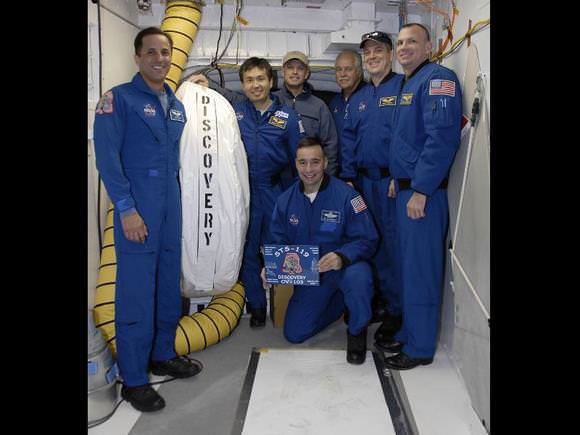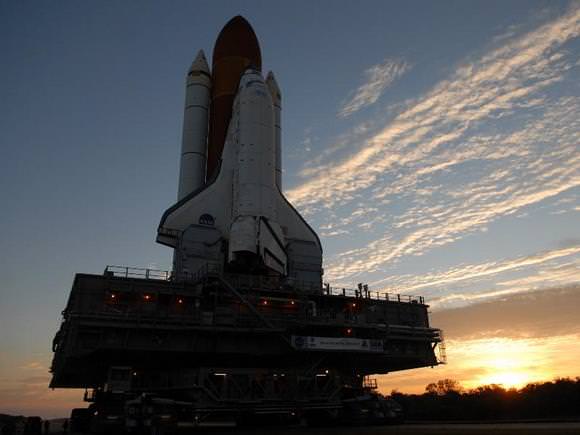[/caption]
NASA announced yet another delay for the launch of the Discovery STS-119 mission to the International Space Station Friday, marking the fourth time the mission has been postponed.
An all-day review of the craft’s readiness for launch left managers still under-confident about the operations of three hydrogen control valves that channel gaseous hydrogen from the main engines to the external fuel tank. Engineering teams have been working to identify what caused damage to a flow control valve on shuttle Endeavour during its November 2008 flight. NASA managers decided Friday more data and possible testing are required before launch can proceed.
“We need to complete more work to have a better understanding before flying,” said Bill Gerstenmaier, associate administrator for Space Operations at NASA Headquarters in Washington. Gerstenmaier chaired Friday’s Flight Readiness Review.
“We were not driven by schedule pressure and did the right thing. When we fly, we want to do so with full confidence.”

Besides understanding what happened with Endeavor’s valves last fall, teams also have tried to determine the consequences if a valve piece were to break off and strike part of the shuttle and external fuel tank.
Meanwhile, the Discovery launch date has shifted from Feb. 12, to Feb. 19, to Feb. 22, Feb. 27 and now — as of last night’s briefing — is postponed until further notice. The Space Shuttle Program has been asked to develop a plan for further inspections. The plan will be reviewed during a meeting on Wednesday, Feb. 25 and a new target launch date may be considered then.
The STS-119 mission is supposed to enhance the solar gathering power of the International Space Station so it might support a larger crew. When it does fly, STS-119 will tote two solar array wings, each of which has two 115-foot-long arrays, for a total wing span of 240 feet, including the equipment that connects the two halves and allows them to twist as they track the sun. Altogether, the four sets of arrays can generate 84 to 120 kilowatts of electricity – enough to provide power for more than 40 average homes.
The mission astronauts arrived at the Kennedy Space Center Jan. 19 and have more or less been in standby mode ever since, shuttling back and forth between Florida and the Johnson Space Center in Houston. On Wednesday of this week, STS-119 mission specialists Richard Arnold and Joseph Acaba were in the Neutral Buoyancy Laboratory at Johnson, brushing up on spacewalk procedures. As of Thursday, the astronauts were in launch-countdown mode which included preflight quarantine.


Standby since Jan 19th, Poor Guys.
Yes… the station will be finished just in time to be de-orbited.
Zvezdichko, the NASA that placed people on the moon was under a lot of pressure from the space race, not to mention the NASA of 40 years ago had a LOT more funding than it did today. We were, after all, racing.
hahaha, very nice Zvezdichko, unfortunately that seems to be the case…over a month in standby…that’s gotta be irritating…
Yes…
What happened to the agency that put men on the Moon with a huge risk of failure? Looks like NASA is very rick-averse today.
Yes risk averse. Kinda of like flying the buran with nobody in it and then parking it in a park?? The truss section weighs 16 tonnes to lose it as well as a ship and crew would would end the iss mission goals.
bill
I timed my visit to Florida a couple years ago so I could watch a shuttle launch. They delayed it for a couple days so I went from my dad’s, in St. Petersburg to visit my sister in Palm Beach, and then I was going to hit KSC on the way back. Unfortunately, they delayed it again for a couple weeks, and I missed it. I’m going to be really pissed if the shuttle is retired before I get to see a launch.
In the article it mentions valve controlling Gaseous Hydrogen flow to the tank from the engine. Shouldn’t this be liquid flow from tank to the engines? I didn’t remember that there were any lines flowing to the tank?
Rechecked the tanks. looks like there is a repressurization line so thats probably what we are talking about here. ignore the prior post 🙂
Space Shuttle is such a big failure. Its risky and easily damaged. NASA needs the Orion like there’s no freakin’ tmrw.
I mean, Soyuz is so reliable. Never heard it delay or fail. Work-Horse of the Russians.
Yep – Soyuz is impressive. But then again, a Soyuz has certainly never placed a Hubble in orbit or anything like that… They are completely different machines for different purposes.
Anyway – just fix Hubble and then retire these awesome machines. Screw the ISS. Get Orion in on the game. There – easy.
The hydrogen is gas because its returning from the main engines into the center fuel tank.
“I mean, Soyuz is so reliable. Never heard it delay or fail. Work-Horse of the Russians.”
Does it have a good overall record? Yes.
Have you heard of Soyuz-1 or Soyuz-11? Apparently not…
And as already noted, no ballistic capsule, launched on an expendable rocket is going to completely fill the Shuttle’s shoes. It’s the *next* US manned spacecraft. I refuse to call it the ‘replacement.’
And not that the Shuttle doesn’t need replacing, but it should have been with a better (even if perhaps smaller) RLV, not a step backwards to the 1960’s…
Frank, I completely agree with you. It seems that we have learned a vast amount about how to ferry equipment into space and with the advances we have made technologically, a smaller, sleeker Space Shuttle seems like the way to go. We could run more missions in tandem and for those missions requiring a larger payload, make the payloads more Modular and use the I.S.S as an assembly station to complete the process of putting together anything that is too big to fit in the new shuttle’s cargo hold.